You’re standing in your Connecticut yard, wondering why your garden struggles while wild plants thrive effortlessly nearby. The secret lies in choosing species that’ve adapted to your region’s clay soils, humid summers, and freezing winters over thousands of years. Native plants require 75% less water, attract twice as many beneficial insects, and resist local pests naturally. But here’s what most gardeners don’t realize about creating this low-maintenance paradise.
Contents
- 1 Connecticut’s USDA Hardiness Zones
- 2 Connecticut’s Stunning Wildflower Varieties
- 3 Connecticut’s Best Native Trees
- 4 Connecticut’s Premier Native Shrubs
- 5 Selecting the Right Native Plants for Your Garden
- 6 Frequently Asked Questions
- 6.1 When Is the Best Time to Plant Native Species in Connecticut?
- 6.2 How Much Do Native Plants Typically Cost Compared to Non-Native Varieties?
- 6.3 Where Can I Purchase Native Plants Locally in Connecticut?
- 6.4 Do Native Plants Require Special Soil Preparation or Amendments?
- 6.5 How Long Does It Take for Native Plants to Become Established?
Connecticut’s USDA Hardiness Zones
Before you can choose the right native plants for your Connecticut garden, you’ll need to understand your local USDA Hardiness Zone. Connecticut’s hardiness zones have shifted due to climate impact, with most areas now classified as zone 6. Zone 6 covers central and inland regions, experiencing winter minimums between 0 to -10°F. Southern coastal areas near Long Island Sound fall into warmer zone 7. The 2023 map updates eliminated zone 5 areas that previously existed in Northwest Connecticut. Understanding these zone changes helps gardeners adapt to shifting climate conditions and select plants that will thrive in their specific location. You can determine your exact zone by entering your ZIP code into the interactive USDA map.
Connecticut’s Stunning Wildflower Varieties
Connecticut’s diverse ecosystems support an impressive array of native wildflowers, from eye-catching meadow species and early spring bloomers to elegant shade-loving woodland varieties. These beautiful plants provide food and shelter for pollinators, birds, and other beneficial creatures throughout the growing season.
Wild Columbine
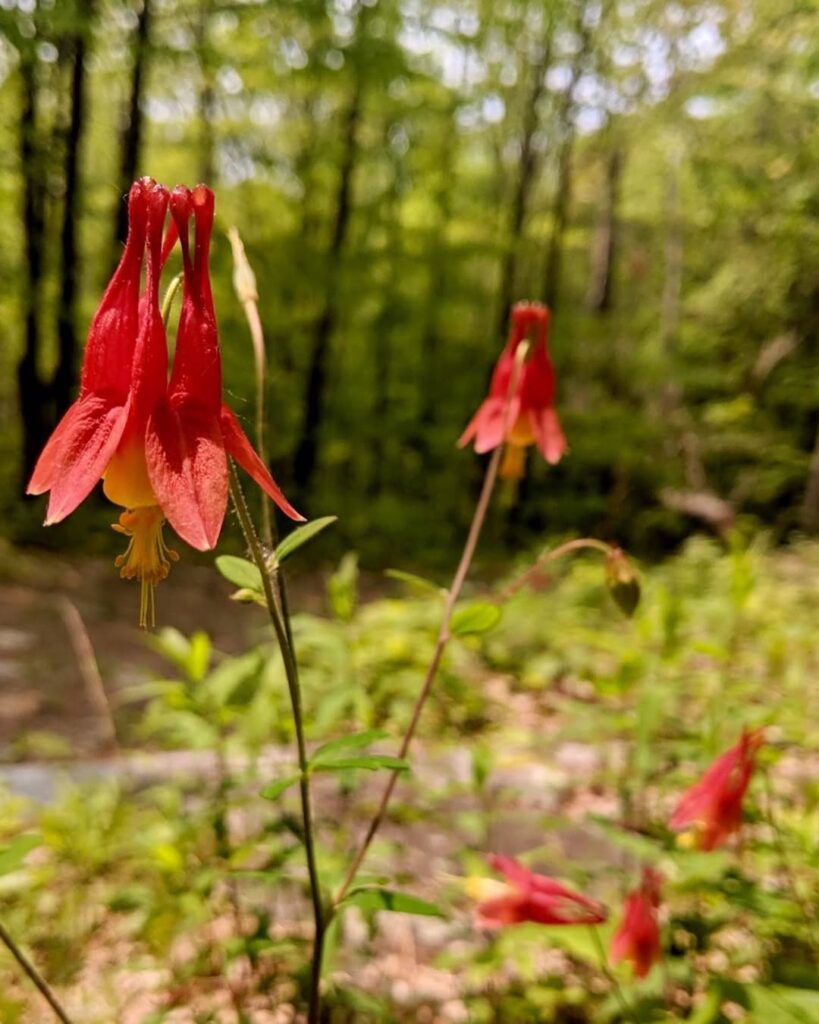
Wild Columbine (Aquilegia canadensis) stands out as one of Connecticut’s most enchanting native wildflowers, featuring distinctive nodding blooms in striking red and yellow combinations. This graceful perennial reaches 2-3 feet in height with an elegant branching habit and blue-green foliage. Its unique eagle claw-shaped petals bloom from February through July, perfectly timed to attract ruby-throated hummingbirds during their migration.
Beyond its ornamental appeal, Wild Columbine offers exceptional garden value as a low-maintenance native that thrives in woodland settings. The plant readily self-seeds and transplants easily, making it an excellent choice for naturalizing in shaded borders or woodland gardens. The genus name Aquilegia derives from the Latin word aquila, meaning eagle, reflecting the flower’s distinctive talon-like nectar spurs.
- Hardiness: Zones 3-8
- Light: Partial shade to full shade
- Water: Moderate; drought tolerant once established
- Soil: Well-draining, calcareous soils; not overly rich
- Fertilizer: None required; thrives in lean soils
- Pest/Disease Resistance: Generally resistant with minimal issues
- Growth Rate: Moderate; readily self-seeds
Wild Bergamot

Wild Bergamot (Monarda fistulosa) is a remarkable native perennial that brings both beauty and ecological value to Connecticut gardens. Growing 2-4 feet tall with distinctive square stems and aromatic grey-green foliage, this stunning wildflower produces unique tubular flowers in shades of lavender, pink, or white that bloom from mid-summer through fall.
This versatile native serves as a pollinator magnet, attracting hummingbirds, butterflies, native bees, and moths while functioning as a larval host for various species. Its aromatic leaves naturally deter deer and rabbits, making it an excellent low-maintenance choice for naturalized areas, borders, and rain gardens. The flowers make excellent cut flowers for indoor arrangements and bouquets.
- Hardiness: Perennial in Connecticut, zones 3-9
- Light: Full sun to partial shade
- Water: Average to moist conditions; drought tolerant once established
- Soil: Adaptable to various types including sandy, loamy, clay; prefers well-drained
- Fertilizer: Low maintenance; no supplemental feeding required
- Pest/Disease Resistance: Generally resistant; may develop powdery mildew without good air circulation
- Growth Rate: Moderate; requires division every 3-4 years for vigor
New England Aster
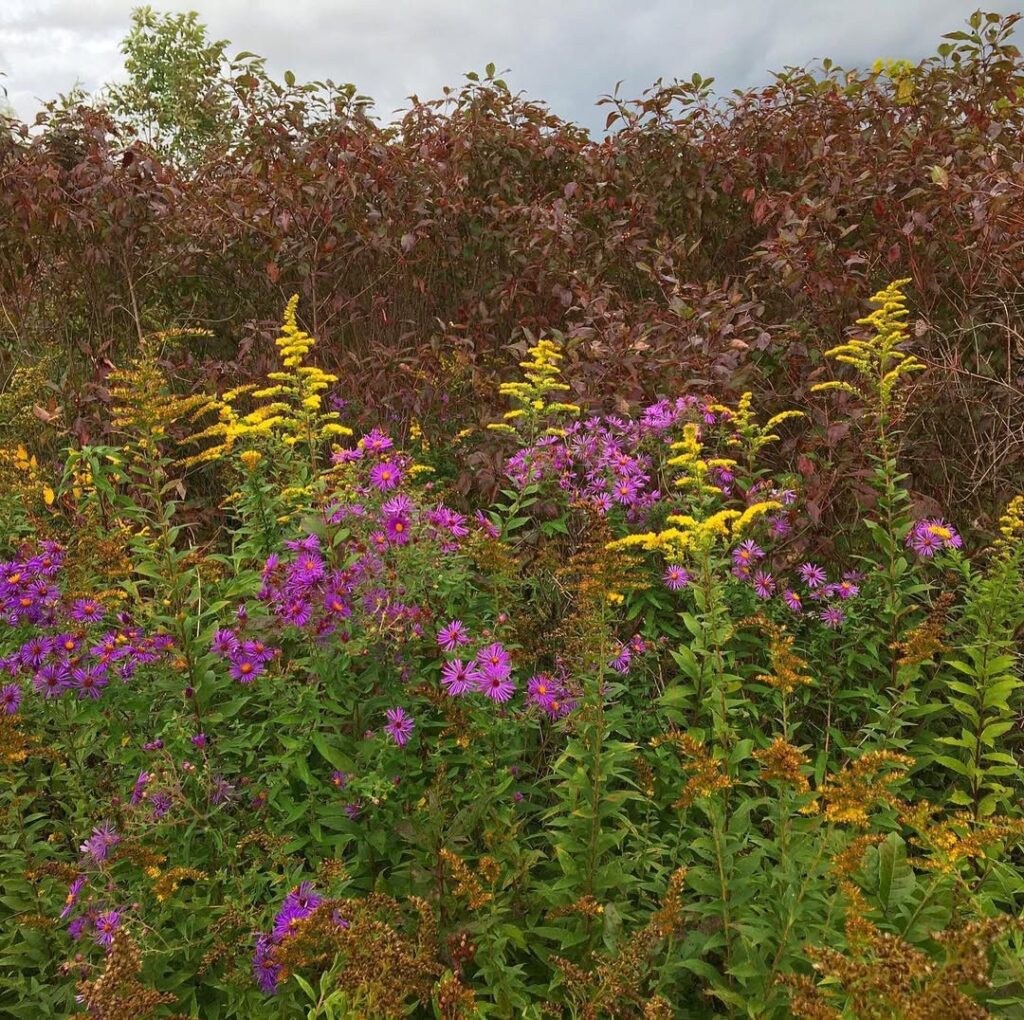
New England Aster stands as one of Connecticut’s most spectacular native wildflowers, creating dense clumps 3-6 feet tall with brilliant rose-purple blooms that light up the autumn landscape. This perennial showcases hairy, clasping leaves on sturdy stems topped with showy flower heads featuring 45-100 ray petals surrounding bright orange-yellow centers. The flowers vary from deep red-purple to lavender, blue, or white depending on the variety.
Beyond its stunning visual appeal, New England Aster serves as an essential wildlife plant, attracting bees, butterflies, and other pollinators when few other flowers remain in bloom. It specifically hosts the Crescent butterfly while providing vital late-season nectar sources. This robust native thrives in Connecticut’s moist meadows, woodland edges, and gardens, offering both ecological value and dramatic ornamental impact through its large, colorful displays that herald the arrival of fall. In garden design, this tall fall bloomer works exceptionally well as a backdrop for shorter plants in mixed perennial borders.
- Hardiness: USDA zones 4-8, native to New England climate conditions
- Light: Full sun to partial shade, adapts to various light conditions
- Water: Medium to moist conditions, thrives with consistent moisture
- Soil: Adaptable to various soil types, prefers well-draining mesic conditions
- Fertilizer: Low maintenance, rarely needs supplemental feeding as native plant
- Pest/Disease Resistance: Rabbit resistant, generally hardy with few serious issues
- Growth Rate: Moderate to fast, spreads naturally to form attractive clumps
Wild Ginger
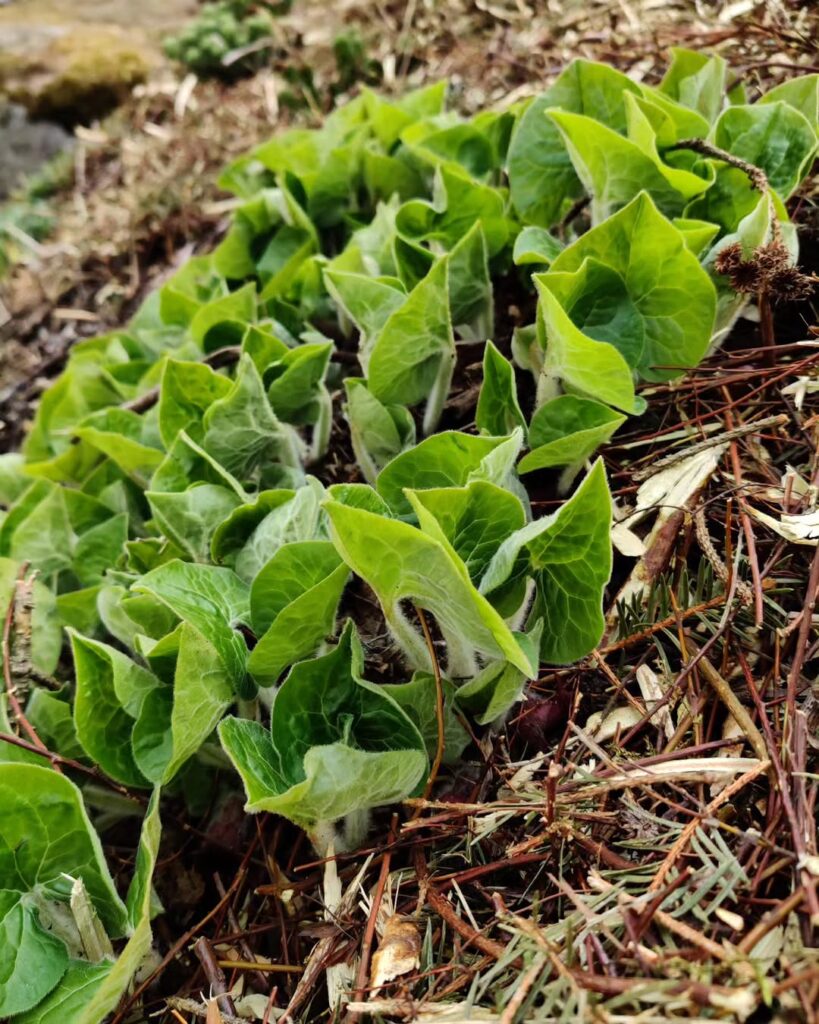
Wild Ginger (Asarum canadense) is a charming native perennial that forms colonies of distinctive heart-shaped, velvety dark green leaves. This low-growing woodland plant produces unique bell-shaped purple-brown flowers that bloom at ground level beneath the foliage in spring. Despite its common name, Wild Ginger is unrelated to culinary ginger, though its roots possess a similar ginger-like scent and have been traditionally used in cooking and medicine.
This exceptional ground cover thrives in Connecticut’s shaded landscapes, spreading slowly by rhizomes to create a dense, manageable carpet of foliage. The plant typically reaches 6 to 12 inches in height while spreading 12 to 18 inches wide, making it perfectly sized for woodland understory plantings. Wild Ginger serves important ecological functions, providing wildlife cover and acting as a larval host for the Pipevine Swallowtail butterfly while attracting other beneficial insects to native garden settings.
- Hardiness: Zones 2-7 (does not tolerate Zone 8 summer heat)
- Light: Part shade to full shade
- Water: Average to wet moisture levels; prefers consistent moisture
- Soil: Acidic, well-drained soil; pH 6-7; moist, rich loam or organic soils
- Fertilizer: Minimal requirements in organic-rich soil
- Pest/Disease Resistance: Generally resistant with few issues
- Growth Rate: Slow to moderate spreading by rhizomes
Wild Lupine

Wild Lupine (Lupinus perennis) stands as one of Connecticut’s most spectacular native wildflowers, producing dramatic spikes of purple-blue pea-like flowers from mid-May through early July. This 1-2 foot tall perennial creates stunning visual impact in gardens while serving critical ecological functions as the sole host plant for the federally endangered Karner Blue Butterfly and supporting numerous other butterfly species.
Despite its showy ornamental appeal, Wild Lupine has experienced significant population declines throughout New England, making its cultivation in home gardens particularly valuable for conservation. The species demonstrates remarkable adaptability, thriving in both anthropogenic habitats like roadsides and railroads as well as natural woodland settings. As a nitrogen-fixing legume, this short-lived perennial actually improves soil health rather than depleting it, contrary to historical misconceptions.
- Hardiness: USDA zones 3-8
- Light: Full sun in northern areas, partial sun in southern regions
- Water: Medium to dry moisture levels; drought tolerant once established
- Soil: Well-drained, acidic soils preferred; adaptable to various soil types
- Fertilizer: None needed; fixes atmospheric nitrogen and improves soil fertility
- Pest/Disease Resistance: Generally good resistance with few serious issues
- Growth Rate: Moderate; short-lived perennial that may experience dormancy periods
Connecticut’s Best Native Trees
Connecticut’s diverse native trees form the backbone of local ecosystems, from mighty oaks supporting hundreds of species to maples dominating forests, plus birches, pines, and other specialized natives. Red maple stands out as the most abundant species, comprising 27% of the state’s native forest trees.
Eastern Red Cedar

Eastern Red Cedar (Juniperus virginiana) is a resilient native evergreen that serves as a pioneer species in Connecticut’s ecological succession. Despite its name, it’s actually a juniper featuring distinctive exfoliating bark and aromatic, rot-resistant heartwood. This adaptable tree produces waxy blue berries that feed numerous bird species and grows 40-50 feet tall with a pyramidal shape.
Thriving in full sun and well-drained soils, Eastern Red Cedar excels in open areas and abandoned fields where shade-intolerant species dominate. Its dual-type foliage—scale-like on mature branches and needle-like on tips—provides year-round wildlife shelter while the aromatic wood naturally repels insects, making it valuable for both ecological and practical applications. The fragrant wood is highly valued for making cedar closets, fenceposts, and even pencil manufacturing due to its natural preservative properties.
- Hardiness: Zones 2-9, extremely cold hardy and heat tolerant
- Light: Full sun required, shade-intolerant
- Water: Drought tolerant once established, moderate water needs
- Soil: Adaptable to various soil types, prefers well-drained conditions
- Fertilizer: Low fertility requirements, thrives in poor soils
- Pest/Disease Resistance: Generally trouble-free with high natural resistance
- Growth Rate: Moderate to fast, especially in favorable conditions
Sugar Maple
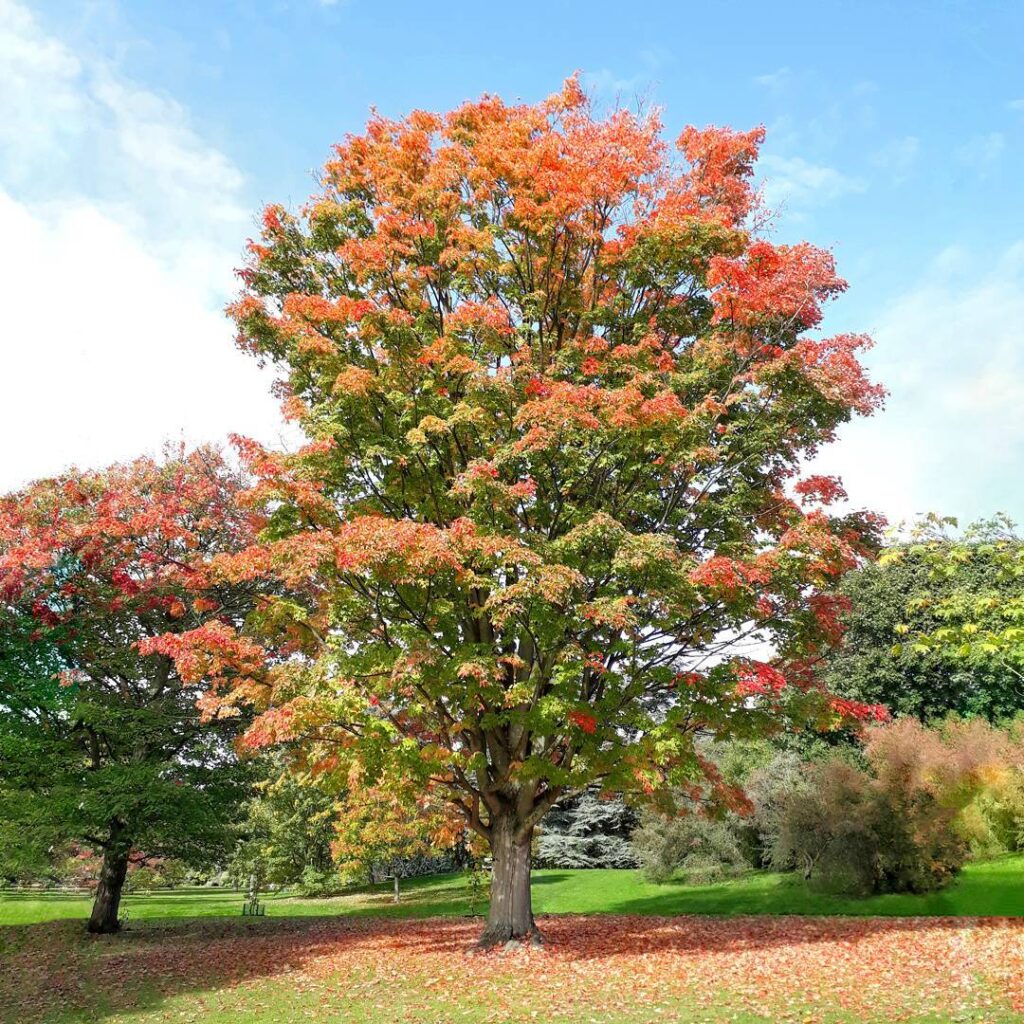
The Sugar Maple stands as Connecticut’s quintessential native tree, reaching 80-100 feet with a dense, oval crown that provides exceptional shade. This deciduous giant transforms Connecticut landscapes each fall with brilliant displays of red, orange, and yellow foliage, making it a cornerstone of New England’s autumn beauty.
Beyond its ornamental value, Sugar Maple serves as an ecological powerhouse, supporting wildlife with seeds and habitat while contributing to forest health through nutrient-rich leaf litter. Its early spring flowers provide nectar for pollinators, and its cultural significance extends from maple syrup production to fine woodworking, representing both natural heritage and economic value. Many specimens planted by colonial settlers continue to thrive today, distinguished by their impressive large trunks and deeply fissured bark that tells the story of centuries past.
- Hardiness: Zones 3-8, well-suited to Connecticut’s climate
- Light: Full sun to partial shade, best growth in full sun
- Water: Consistent moisture preferred, intolerant of drought stress
- Soil: Moist, well-drained, slightly acidic to fertile soils; requires deep, well-aerated conditions
- Fertilizer: Generally not needed in fertile soils; benefits from organic matter
- Pest/Disease Resistance: Moderate; susceptible to verticillium wilt and urban stress-related issues
- Growth Rate: Slow to medium, faster juvenile growth in ideal conditions
American Elm

The American Elm is a majestic deciduous tree native to Connecticut, reaching heights of 21-35 meters with its distinctive vase-shaped canopy. Known for its fast growth and longevity of 175-200 years, this adaptable species thrives in diverse habitats from wetlands to urban environments. Historically prized as a street tree for its arching form and shade, the American Elm provides valuable wildlife habitat and supports pollinators with its spring flower clusters.
While nearly decimated by Dutch Elm Disease, ongoing breeding programs are developing disease-resistant varieties for restoration. The tree’s distinctive features include simple, double-toothed leaves, deeply furrowed bark with a lace-like appearance, and samara fruits. Its ecological value extends beyond beauty, contributing to forest nutrient cycling and supporting numerous bird and mammal species. The wood’s interlocking grain structure makes it particularly valued for specialized applications like veneer production and hockey stick manufacturing.
- Hardiness: Zones 3-9
- Light: Full sun to partial shade
- Water: Moderate to high moisture; tolerates wet conditions
- Soil: Adapts to various pH levels; prefers moist, fertile soils; tolerates some salinity
- Fertilizer: Low maintenance; benefits from organic matter
- Pest/Disease Resistance: Susceptible to Dutch Elm Disease, aphids, elm leaf beetle, and various fungal disorders
- Growth Rate: Fast-growing
White Oak
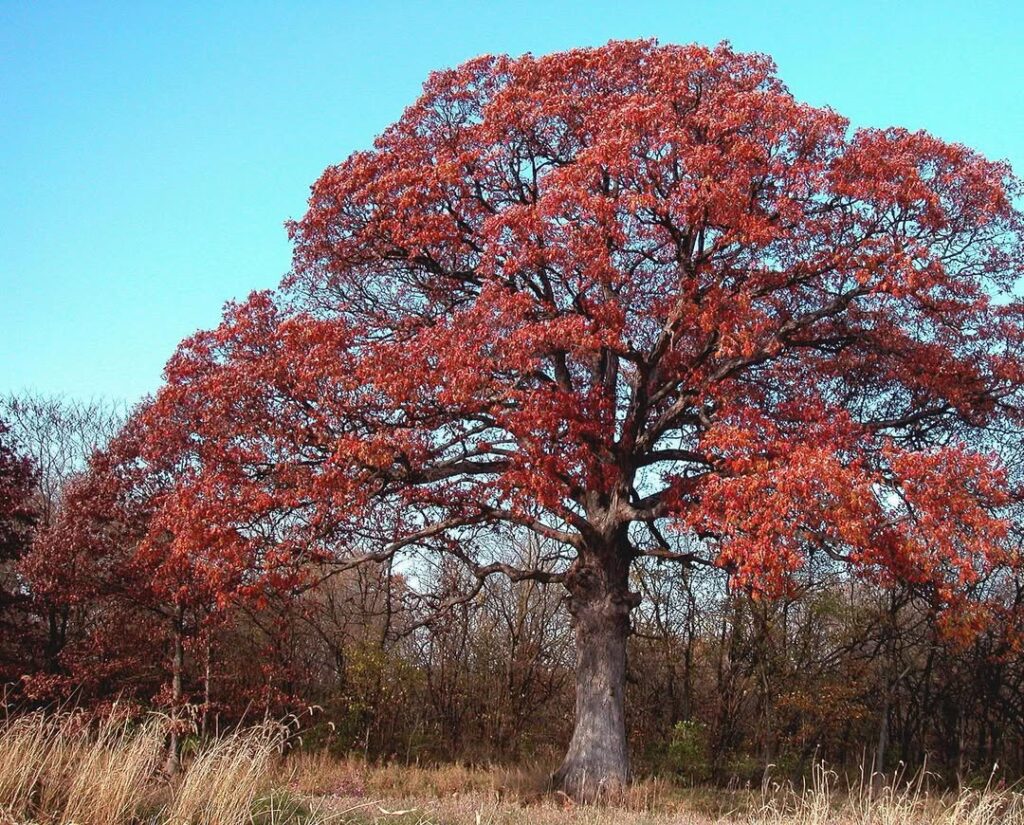
The White Oak is Connecticut’s state tree and one of New England’s most magnificent native species. This deciduous giant reaches 60-80 feet tall with distinctive oval leaves featuring 7-10 rounded lobes that emerge bright red in spring, mature to yellow-green in summer, and turn deep red in fall. Known for exceptional longevity of over 600 years, White Oak produces characteristic acorns with warty caps and develops attractive gray bark that forms loose strips with age.
White Oak grows slower than other native oaks but proves remarkably durable and adaptable. Its monoecious flowers produce good acorn crops every 4-10 years, supporting wildlife while the tree establishes itself as a cornerstone species in Connecticut’s forest ecosystems. The species has deep historical roots in Connecticut, as the famous Charter Oak in Hartford concealed the Connecticut Charter of 1662 from British authorities.
- Hardiness: Zones 3-9, extremely cold hardy and heat tolerant
- Light: Full sun to partial shade, deeper leaf lobes develop in full sun
- Water: Moderate moisture needs, drought tolerant once established
- Soil: Well-drained soils, adaptable to various pH levels, thrives in rich bottomlands
- Fertilizer: Generally unnecessary, benefits from organic matter incorporation
- Pest/Disease Resistance: Excellent resistance, one of the toughest forest trees
- Growth Rate: Slow to moderate, slower than other New England oaks
American Beech
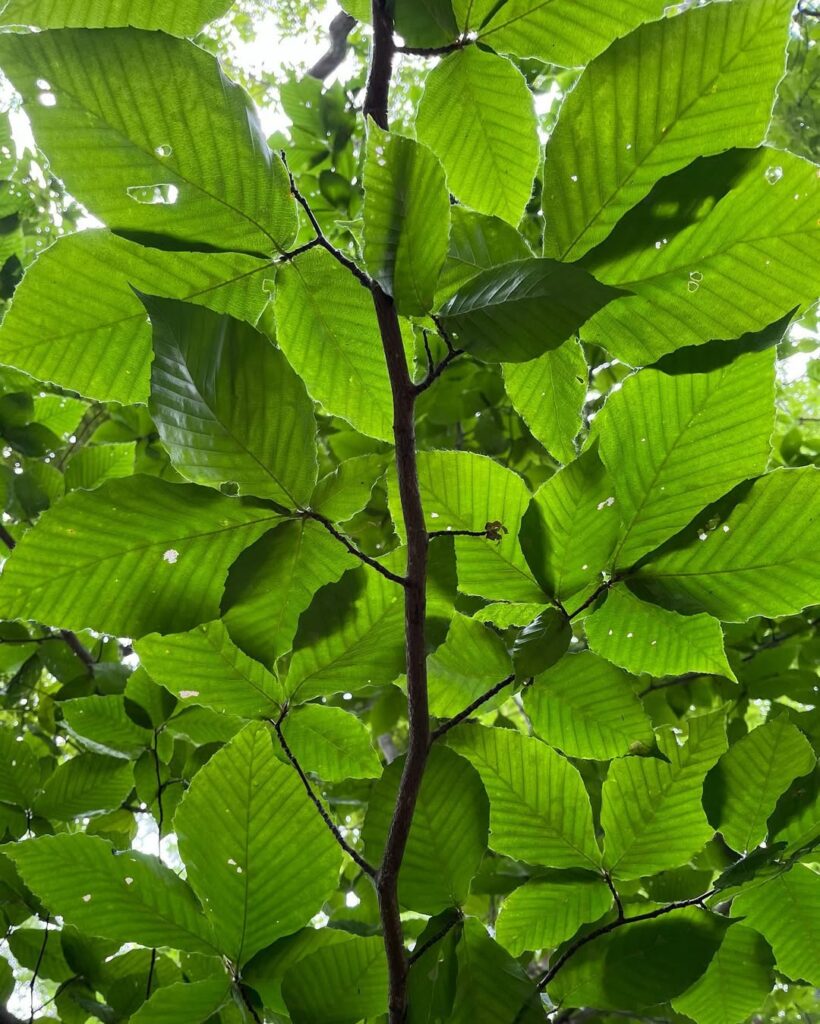
The American Beech is a majestic native tree that can reach 50-80 feet tall with a distinctive wide-spreading, rounded crown. This Connecticut native is prized for its smooth, light gray bark that remains unchanged with age, glossy dark green leaves that turn copper in fall, and ecological value as a wildlife food source through its edible beechnuts.
As a slow-growing but long-lived specimen, American Beech serves as an excellent shade tree for large properties and naturalized landscapes. Its dense canopy provides important habitat for native wildlife while its persistent winter leaves add year-round texture. The tree’s horizontal branching pattern and symmetrical form make it an attractive focal point in sustainable landscape designs. For detailed information about this species, the University of Connecticut Plant Database serves as an excellent research resource for gardeners and landscapers.
- Hardiness: Zones 3-9, native to Connecticut and eastern North America
- Light: Full sun to partial shade; shade-tolerant but grows best in sun
- Water: Moderate moisture requirements; prefers consistently moist but well-drained conditions
- Soil: Well-drained, acidic soils; intolerant of wet, compacted, or alkaline conditions
- Fertilizer: Generally not needed when planted in appropriate soil conditions
- Pest/Disease Resistance: Generally healthy but can be susceptible to beech bark disease
- Growth Rate: Slow to moderate growth rate with long lifespan
Connecticut’s Premier Native Shrubs
Connecticut offers exceptional native shrubs that provide year-round beauty, wildlife habitat, and low-maintenance gardening solutions, with evergreen options and specialized cultivars available through local nurseries. These hardy plants naturally deter diseases and insect infestations while offering essential food, cover, and shelter for local wildlife.
Spicebush
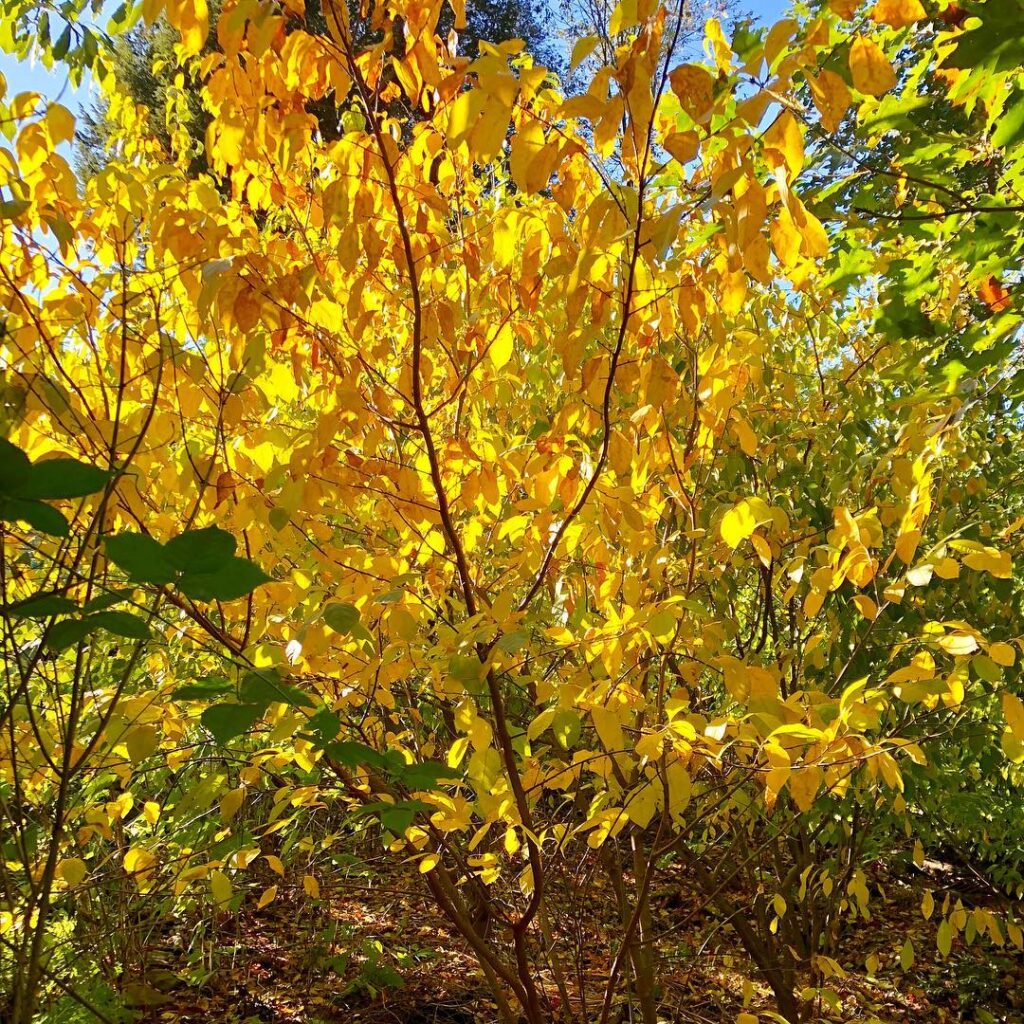
Spicebush stands out as one of Connecticut’s most versatile native shrubs, offering year-round interest in woodland gardens and naturalized landscapes. This deciduous beauty reaches 6-12 feet in height with an equally wide spread, featuring graceful multi-stemmed growth and glossy foliage that releases a distinctive spicy fragrance when touched.
The shrub provides exceptional seasonal appeal, beginning with cheerful lemon-yellow flowers that brighten the early spring landscape before leaves emerge. Female plants develop attractive red berries following the blooming period. Several special forms of spicebush exist, including non-fruiting varieties like Green Gold with large ornamental yellow blooms and Rubra featuring deep red-brown flowers. Spicebush serves as a vital host plant for spicebush swallowtail butterflies while adapting well to various growing conditions throughout Connecticut’s diverse landscapes.
- Hardiness: USDA zones 4-9
- Light: Full sun to full shade, performs best in partial shade
- Water: Prefers consistent moisture, tolerates wet conditions
- Soil: Moist, well-drained sandy, loamy, or limestone-based soils
- Fertilizer: No supplemental fertilization needed
- Pest/Disease Resistance: Excellent, no serious problems
- Growth Rate: Fast-growing
Elderberry
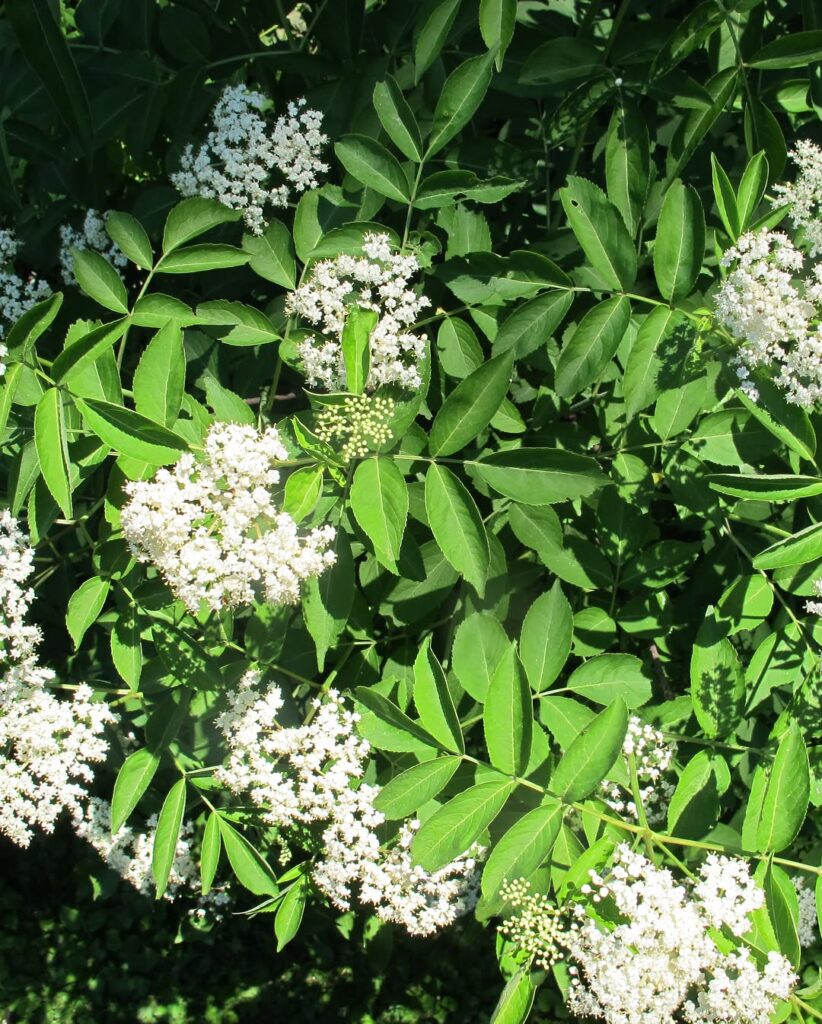
Elderberry (Sambucus canadensis) stands out as one of Connecticut’s most valuable native shrubs, offering exceptional wildlife benefits and garden versatility. This fast-growing, multi-stemmed deciduous shrub produces stunning flat-topped clusters of creamy-white flowers in late spring, followed by dark purple-black berries that are prized by both wildlife and gardeners. Growing 5-12 feet tall with an attractive rounded form, elderberry adapts to diverse conditions from wetlands to naturalized borders.
Native throughout eastern North America, elderberry thrives in Connecticut’s varied landscapes, from riparian areas to old fields. Its dense growth provides vital nesting habitat for birds while supporting pollinators with abundant nectar. The edible berries can be harvested for jams and syrups, though leaving some guarantees continued wildlife food sources through late summer and fall. For enhanced fruit production, consider selecting cultivars like Adams and York that have been specifically chosen for larger, more numerous fruits.
- Hardiness: USDA zones 3-9
- Light: Full sun to partial shade (best flowering in full sun)
- Water: Moist, consistent moisture preferred; drought tolerant once established
- Soil: Fertile, well-draining soil; tolerates wet conditions and various soil types
- Fertilizer: Low maintenance; benefits from compost or organic matter
- Pest/Disease Resistance: Generally resistant with few serious issues
- Growth Rate: Fast
Witch Hazel
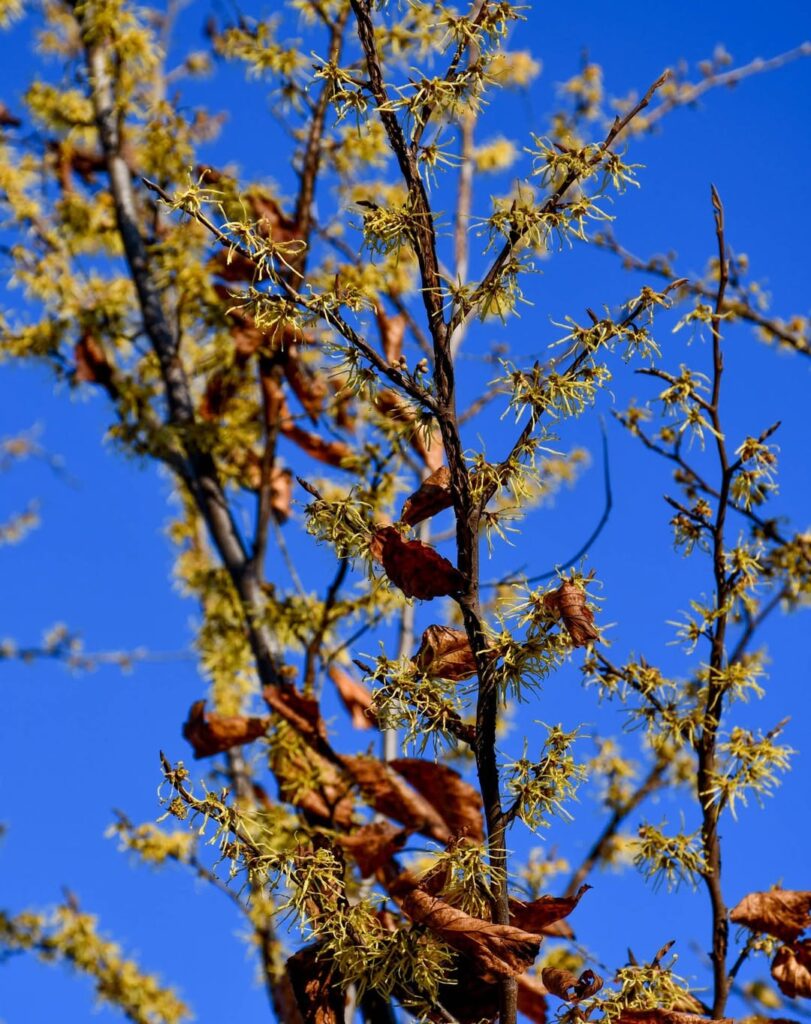
Witch hazel stands as one of Connecticut’s most remarkable native shrubs, offering unique late-season beauty when most plants have finished their show. This multi-stemmed shrub grows 15-20 feet tall with a distinctive vase shape, producing fragrant yellow flowers with twisted, ribbon-like petals from October through December. The blooms appear alongside brilliant golden fall foliage, creating stunning displays in otherwise dormant landscapes.
Beyond its ornamental value, witch hazel carries deep historical significance in Connecticut, with its bark and twigs used to produce the famous astringent and its forked branches traditionally employed as divining rods. The plant’s ability to colonize through underground suckers makes it excellent for naturalized plantings, while its extended flowering period provides essential late-season resources for pollinators. After flowering, the plant develops distinctive fruits that explosively release small black seeds, sometimes launching them up to 30 feet away to establish new colonies.
- Hardiness: Zones 3-8, extremely cold tolerant
- Light: Full sun to partial shade, adaptable to woodland conditions
- Water: Moderate moisture, drought tolerant once established
- Soil: Adaptable to various soil types, prefers well-draining conditions
- Fertilizer: Low maintenance, rarely requires supplemental feeding
- Pest/Disease Resistance: Excellent resistance, very few problems
- Growth Rate: Moderate, reaches maturity in 10-15 years
Mountain Laurel

Mountain Laurel stands as Connecticut’s official state flower and one of the most spectacular native shrubs for regional gardens. This broadleaf evergreen produces stunning clusters of pink-budded flowers that open to white or pale pink blooms with distinctive purple spots in late spring. The glossy, dark green foliage provides year-round interest while the plant’s slow-growing nature and exceptional hardiness make it ideal for low-maintenance landscapes.
Beyond its ornamental value, Mountain Laurel serves as an important wildlife plant, attracting butterflies, hummingbirds, and native bees through its unique spring-loaded stamen mechanism. The shrub functions as a larval host for several moth species, including the specialized Laurel Sphinx moth, making it valuable for supporting native ecosystems. All parts of the plant are toxic if ingested, making proper placement important in landscapes with children and pets.
- Hardiness: Extremely hardy, suitable for Connecticut’s climate zones
- Light: Full sun to partial shade
- Water: Adaptable from dry to moist conditions
- Soil: Acidic, well-drained soil preferred
- Fertilizer: Low maintenance, minimal fertilizer needs
- Pest/Disease Resistance: Generally low pest issues, some susceptibility to leaf spots and blights
- Growth Rate: Slow-growing, reaching 5-20 feet in height and width
Viburnum Mapleleaf Shrub
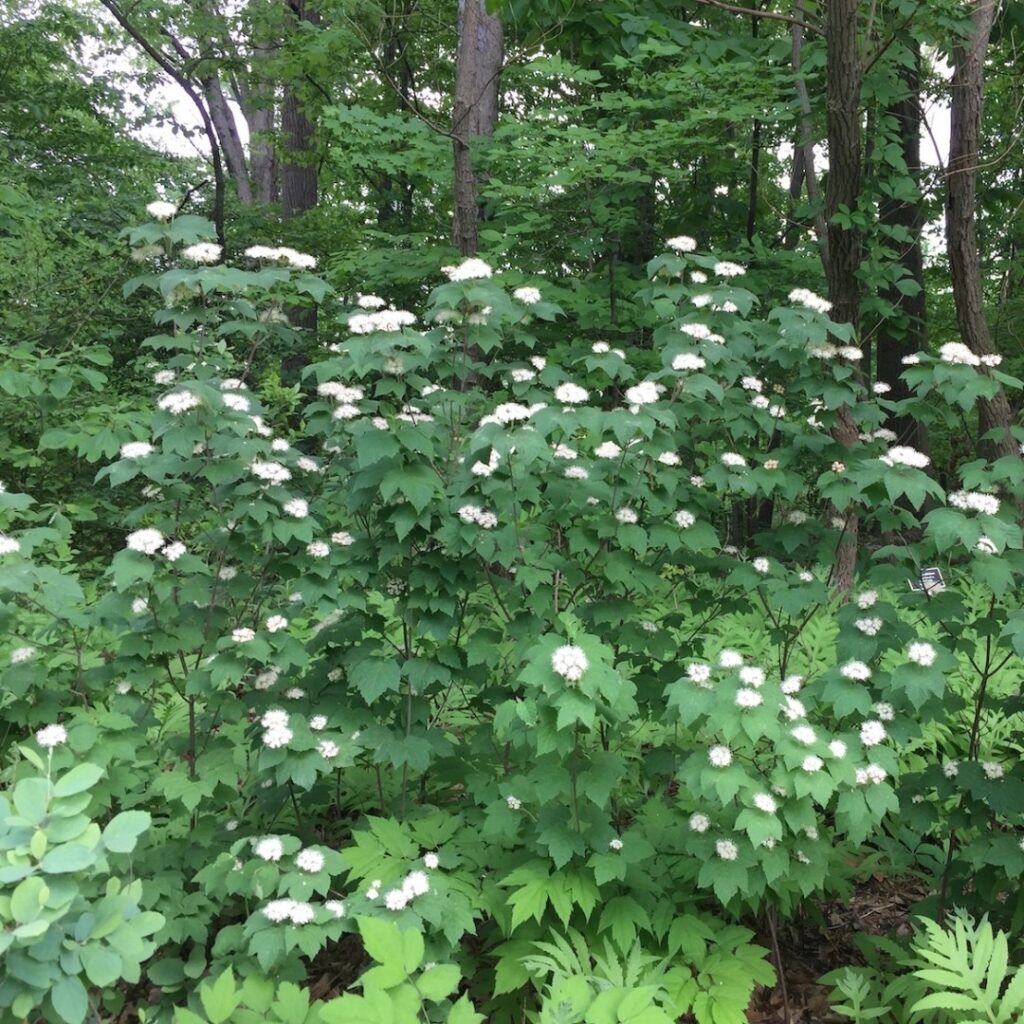
The Viburnum Mapleleaf Shrub is a versatile native deciduous shrub that reaches 4-6 feet in height and width. Distinguished by its distinctive 3-lobed, maple-like leaves and upright growth habit, this multi-stemmed shrub produces clusters of small yellowish-white flowers in late spring followed by blue-black berries in fall.
This adaptable Connecticut native thrives in woodland understories and forest edges, making it excellent for naturalizing and shrub borders. Its vibrant reddish-purple fall foliage and persistent fruit clusters provide year-round ornamental interest while supporting local wildlife. The plant’s suckering habit allows it to form colonies, making it valuable for erosion control and mass plantings in native landscape designs. The dense growth of this shade-tolerant shrub provides excellent cover for forest floor nesting birds.
- Hardiness: USDA Zone 4
- Light: Partial shade preferred; tolerates full sun to deep shade
- Water: Moderate; adaptable to both moist and dry conditions, drought tolerant once established
- Soil: Well-drained, mildly acidic soils preferred; adaptable to various soil types
- Fertilizer: Low maintenance; typically requires no supplemental fertilization
- Pest/Disease Resistance: Generally pest-free; occasionally susceptible to bacterial leaf spot and nematodes
- Growth Rate: Moderate
Selecting the Right Native Plants for Your Garden
When choosing native plants for your Connecticut garden, you’ll want to match each species to your specific site conditions rather than forcing plants into unsuitable spots. Consider your garden’s microclimates—sunny areas, shaded corners, wet spots, and dry zones all need different plants.
The native plant benefits include natural drought tolerance and pest resistance, making your maintenance easier. Native plants are also essential for supporting local pollinators and wildlife, contributing to local food webs. Focus on nursery-propagated species to protect wild populations. Create layers in your garden design using tall trees like White Oak, mid-level shrubs such as Mountain Laurel, and groundcovers like Pennsylvania Sedge for ideal wildlife habitat and visual appeal.
Frequently Asked Questions
When Is the Best Time to Plant Native Species in Connecticut?
Like nature’s own calendar turning its pages, you’ll find the ideal planting schedule through seasonal considerations: late March to early May for spring vigor, or late September to early November for roots.
How Much Do Native Plants Typically Cost Compared to Non-Native Varieties?
You’ll find native plant pricing higher upfront, with 4-inch perennials costing $12-18 versus $2.50 for non-natives. However, cost comparisons show natives save money long-term through reduced maintenance needs.
Where Can I Purchase Native Plants Locally in Connecticut?
You can purchase native plants from specialized native plant nurseries like Earth Tones in Woodbury or Eden’s Natives in Tolland. Garden centers like Bell Nurseries also carry selections, plus online plant retailers offer convenient delivery options.
Do Native Plants Require Special Soil Preparation or Amendments?
You typically don’t need special soil preparation for native plants since they’ve adapted to Connecticut’s native soil composition over thousands of years. Simply match plants to your existing native soil conditions for best results.
How Long Does It Take for Native Plants to Become Established?
Most Connecticut natives need 2-3 years for full establishment. Your establishment timeline depends on growth factors like soil preparation, planting timing, and watering. You’ll see vigorous blooms by year three following proper care.
